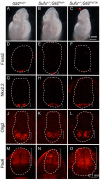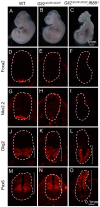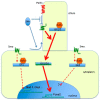Distinct Activities of Gli1 and Gli2 in the Absence of Ift88 and the Primary Cilia
- PMID: 30791390
- PMCID: PMC6473256
- DOI: 10.3390/jdb7010005
Distinct Activities of Gli1 and Gli2 in the Absence of Ift88 and the Primary Cilia
Abstract
The primary cilia play essential roles in Hh-dependent Gli2 activation and Gli3 proteolytic processing in mammals. However, the roles of the cilia in Gli1 activation remain unresolved due to the loss of Gli1 transcription in cilia mutant embryos, and the inability to address this question by overexpression in cultured cells. Here, we address the roles of the cilia in Gli1 activation by expressing Gli1 from the Gli2 locus in mouse embryos. We find that the maximal activation of Gli1 depends on the cilia, but partial activation of Gli1 by Smo-mediated Hh signaling exists in the absence of the cilia. Combined with reduced Gli3 repressors, this partial activation of Gli1 leads to dorsal expansion of V3 interneuron and motor neuron domains in the absence of the cilia. Moreover, expressing Gli1 from the Gli2 locus in the presence of reduced Sufu has no recognizable impact on neural tube patterning, suggesting an imbalance between the dosages of Gli and Sufu does not explain the extra Gli1 activity. Finally, a non-ciliary Gli2 variant present at a higher level than Gli1 when expressed from the Gli2 locus fails to activate Hh pathway ectopically in the absence of the cilia, suggesting that increased protein level is unlikely the major factor underlying the ectopic activation of Hh signaling by Gli1 in the absence of the cilia.
Keywords: Gli3; Hh signaling; Shh; Smo; Sufu; intraflagellar transport; mouse; neural tube; patterning.
Conflict of interest statement
The authors declare no conflict of interest. The funders had no role in the design of the study; in the collection, analyses, or interpretation of data; in the writing of the manuscript, or in the decision to publish the results.
Figures








References
Grants and funding
LinkOut - more resources
Full Text Sources
Molecular Biology Databases
Miscellaneous

